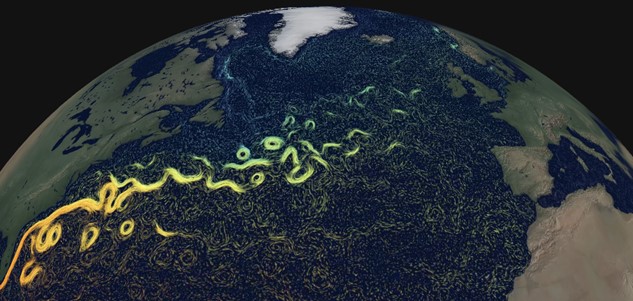The image above is part of an amazing interactive graphic in a New York Times article [1] describing the alarming changes in the Gulf Stream which may have consequences for our Irish climate. The article describes how scientists fear that the warming atmosphere is causing part of the powerful Gulf Stream to weaken.
Ocean circulation is strongly linked to atmospheric circulation as surface currents in the ocean are driven by winds though a transfer of energy from the air to the water by friction. Currents bring warm water west from Africa across the top of South America, through the Caribbean and Gulf of Mexico, up the east coast of the United States, and eventually across to Europe in the form of the Gulf Stream. This warm current influences our weather making it milder than it should be for our latitude. As the warm water travels into the North Atlantic, evaporation and cooling occurs which increases its salinity and density. This cool dense water sinks deep into the ocean, or is ‘overturned’, and eventually is pushed back south as part of the Atlantic Meridional Overturning Circulation (AMOC).
Meanwhile, the Greenland ice sheet, which faces irreversible melting according to a study quoted in Science Daily [2], is losing freshwater as its ice cap melts, contributing to almost 1mm in sea level rise per year. This sudden influx of freshwater which is lighter than saltwater could have impeded the sinking of denser, saltier water — that critical “overturning” phase of the AMOC. Scientists have strong evidence from ice and sediment cores that the AMOC has weakened and shut down before in the past 13,000 years. As a result, mean temperatures in parts of Europe may have rapidly dropped to about 15 degrees Celsius below today’s averages, ushering in arctic like conditions. As average temperatures rise almost everywhere around the world, part of the North Atlantic southeast of Greenland has become colder in recent years. This cold section may be inhibiting the northern arm of the Gulf Stream, which may in turn change our temperate Irish climate. Around the world the change could cause faster sea-level rise along the Eastern United States, stronger hurricanes in the Southeast US and reduced rainfall in the Sahel of Africa.
A 2019 report by the United Nations’ Intergovernmental Panel on Climate Change [3], says that while the AMOC will “very likely” weaken later this century, collapse is “very unlikely” if global warming is limited to 1.5 degrees C above pre-industrial times. In light of these studies, we must act now to fight climate change and avoid losing the influential Gulf Stream.
[1] In the Atlantic Ocean, Subtle Shifts Hint at Dramatic Dangers - The New York Times [2] Greenland ice sheet faces irreversible melting - Science Daily [3] Special Report on the Ocean and Cryosphere in a Changing Climate - IPCC
Additional information from: Arbogast, A. F. (2014) Discovering Physical Geography. 3rd edition. Hoboken, N.J., John Wiley & Sons.

